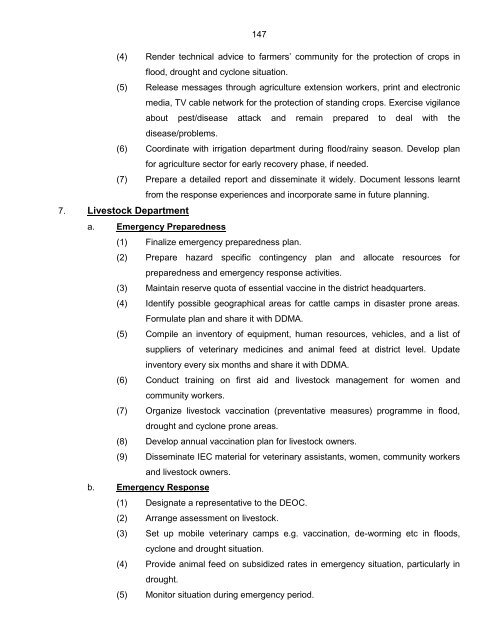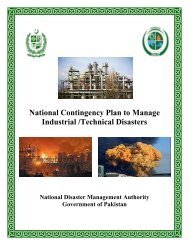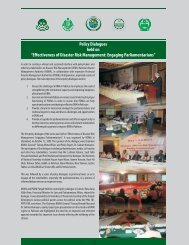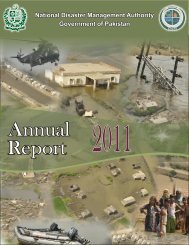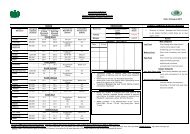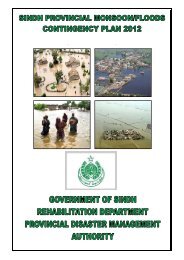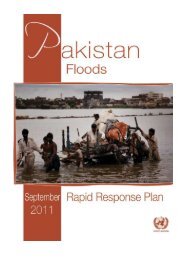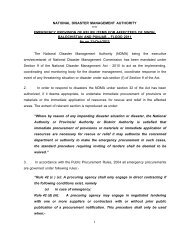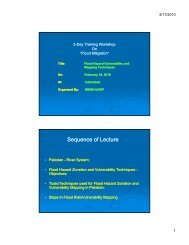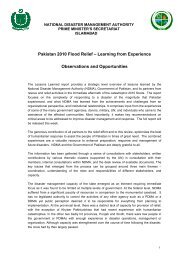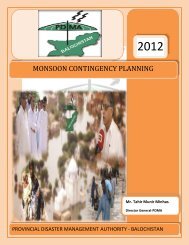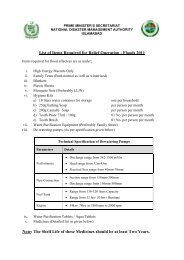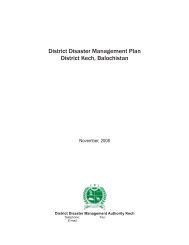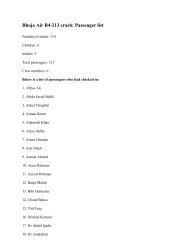National Disaster Response Plan (NDRP) March 2010 - NDMA
National Disaster Response Plan (NDRP) March 2010 - NDMA
National Disaster Response Plan (NDRP) March 2010 - NDMA
You also want an ePaper? Increase the reach of your titles
YUMPU automatically turns print PDFs into web optimized ePapers that Google loves.
147<br />
(4) Render technical advice to farmers‟ community for the protection of crops in<br />
flood, drought and cyclone situation.<br />
(5) Release messages through agriculture extension workers, print and electronic<br />
media, TV cable network for the protection of standing crops. Exercise vigilance<br />
about pest/disease attack and remain prepared to deal with the<br />
disease/problems.<br />
(6) Coordinate with irrigation department during flood/rainy season. Develop plan<br />
for agriculture sector for early recovery phase, if needed.<br />
(7) Prepare a detailed report and disseminate it widely. Document lessons learnt<br />
7. Livestock Department<br />
from the response experiences and incorporate same in future planning.<br />
a. Emergency Preparedness<br />
(1) Finalize emergency preparedness plan.<br />
(2) Prepare hazard specific contingency plan and allocate resources for<br />
preparedness and emergency response activities.<br />
(3) Maintain reserve quota of essential vaccine in the district headquarters.<br />
(4) Identify possible geographical areas for cattle camps in disaster prone areas.<br />
Formulate plan and share it with DDMA.<br />
(5) Compile an inventory of equipment, human resources, vehicles, and a list of<br />
suppliers of veterinary medicines and animal feed at district level. Update<br />
inventory every six months and share it with DDMA.<br />
(6) Conduct training on first aid and livestock management for women and<br />
community workers.<br />
(7) Organize livestock vaccination (preventative measures) programme in flood,<br />
drought and cyclone prone areas.<br />
(8) Develop annual vaccination plan for livestock owners.<br />
(9) Disseminate IEC material for veterinary assistants, women, community workers<br />
and livestock owners.<br />
b. Emergency <strong>Response</strong><br />
(1) Designate a representative to the DEOC.<br />
(2) Arrange assessment on livestock.<br />
(3) Set up mobile veterinary camps e.g. vaccination, de-worming etc in floods,<br />
cyclone and drought situation.<br />
(4) Provide animal feed on subsidized rates in emergency situation, particularly in<br />
drought.<br />
(5) Monitor situation during emergency period.


